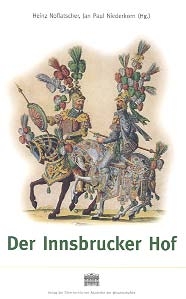

Der Sammelband schafft erstmals einen Überblick zur Geschichte des Innsbrucker Hofes vom 15. Jahrhundert bis zum Ende des Ancien Régime. Er ist Ergebnis eines Kolloquiums, das am 6. und 7. Juni 2002 in Innsbruck von der Historischen Kommission der Österreichischen Akademie der Wissenschaften und dem Institut für Geschichte der Universität Innsbruck veranstaltet wurde. Insgesamt 13 Autorinnen und Autoren aus England, Tschechien, Russland, Italien, Deutschland und Österreich analysierten Funktionen, Wandel und Erscheinungsbilder eines vorwiegend residenten Hofes, der auch das monumentale Erscheinungsbild der Stadt nachhaltig prägte. In einem ersten Abschnitt werden Normen und Repräsentation, in einem zweiten die höfischen Feste und Symbiosen der Stadt mit dem Hof, in einem dritten Abschnitt Rollen und kulturelle Transferfunktionen der Frau am Hof untersucht. Ein letzter Teil analysiert Fragen der regionalen Integration. Im Besonderen konnte die Maklerposition der Tiroler Hofgesellschaft besser verortet, der alte Topos auch der Stadt Innsbruck als Kulturvermittlerin und Transitstation auf dem Weg nach Italien insbesondere in der Renaissance präzisiert werden. Der Innsbrucker Hof wirkte als ein nicht unbedeutendes Bindeglied im intra- und interdynastischen Austausch der europäischen Vormoderne.
…
The anthology provides a very first overview of the history of the Innsbruck Court from the 15th century to the end of the Ancien Régime, thus meeting a substantial research desideratum. It is the result of a colloquium that took place on 6 and 7 June 2002 in Innsbruck, organised by the Historic Commission of the Austrian Academy of Sciences and the Institute for History at Innsbruck University. No fewer than 13 authors from England, the Czech Republic, Russia, Italy, Germany and Austria analysed the functions, change and appearance of what was largely a residential court that has also had a lasting influence on the visual appearance of the city.
The first section analyses standards and representation, the second deals with the festivities at court and forms of symbioses of court and city, a third section examines the role and cultural transfer functions of women at court and a final chapter gives thought to questions of regional integration. The contributions give, for the first time, a greater preciseness to what was known of the Innsbruck court. In particular, it has made it possible to better determine the position of Tyrolean court society as a mediator and, the old topic of the city of Innsbruck as a conveyer of culture and as a transit station on the way to Italy, particularly during the Renaissance, was able to be identified more precisely. The Innsbruck court acted as a significant link in the intra- and inter-dynastic exchange of pre-modern Europe.
2004
978-3-7001-3327-8
416 Seiten, 16 Seiten farbiger Bildteil
24x15 cm, broschiert